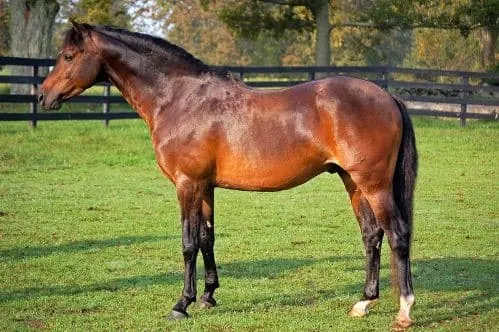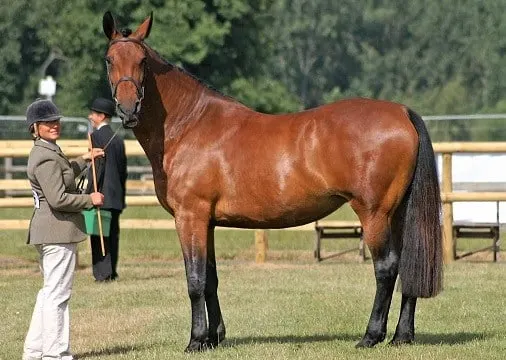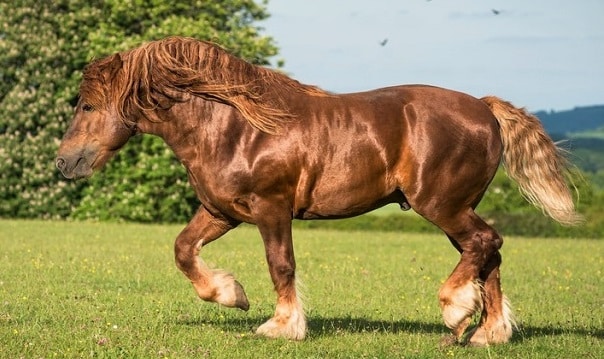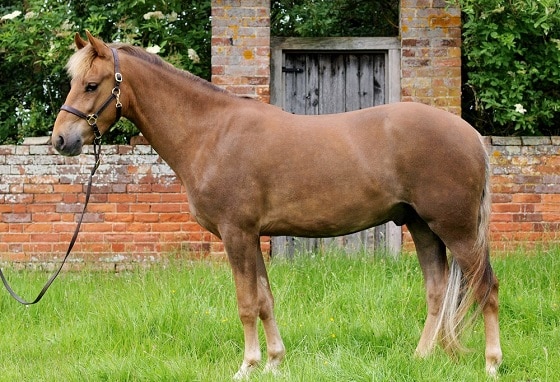British horse breeds are one of the most influential in the world and can be found amongst the ancestors of many modern horse breeds. Such examples are the Thoroughbred, the Shetland Pony, or the stylish Hackney Horse.
Britain’s defining effect on the world’s equine population is of little surprise, given that horse breeding is deeply ingrained in British culture. Although horses have existed here since prehistoric times, the formation of distinct breeds only started in the Middle Ages.
Some defining moments of British horse breeding were the first imports of oriental horses (11th century), Flemish stallions (13th century), and Spanish stallions (14th century). By the 17th century, the quality of British stock has gained recognition across Europe with demands rising rapidly.
Today, the Thoroughbred is undoubtedly the most famous and successful English horse breed of all time. The breed has produced numerous world-class racehorses, including Fusaichi Pegasus, the most expensive horse ever selling for $70 million!
15 common English and British horse breeds:
Thoroughbred

Robert Ranson / Shutterstock.com
The Thoroughbred is one of the most popular horse breeds in the world. Originating in 17th century England, they have soon spread around the world and numbers are in the millions today. Thoroughbreds dominate the horse racing industry on every continent and have produced some of the most famous and expensive horses in history.
All modern Thoroughbreds can be traced back to three founding stallions imported to England during the 17th and 18th centuries. These are the Darley Arabian, the Godolphin Arabian, and the Byerley Turk. The three Oriental stallions were then bred to local mares to create the racehorse we see today.
This fast horse breed has been extremely influential and has founded several modern horse breeds such as the Quarter Horse, Anglo-Arabian, or the harness racing Standardbred.
Thoroughbreds are high-spirited horses that are born to run. They stand between 15.2 and 17 hands tall, with the most successful racehorses averaging 16 hands. Thoroughbreds can be of most solid colors and are often bay, chestnut, gray or black.
Thoroughbreds aren’t just good racehorses but are also successful in many English disciplines such as hunter/jumper, dressage, or polo. It’s not uncommon that horses not fast enough for the racetrack are adopted by hobby riders and make a great family or pleasure horses.
Also read: How Fast Can a Horse Run?
Shire Horse

olgaru79 / Shutterstock.com
Originating in 18th century England, this British draft horse breed is extreme in every way. The Shire breed holds the world record for the tallest, largest, and oldest horse ever lived on the planet! Despite being the giants of the horse world, they are of a gentle nature and can even be safely handled by children.
Amongst the ancestors of the Shire Horse were the English Great Horse and the Friesian. The crosses of these two breeds later created the Old English Black, which is the direct forerunner of the modern Shire breed. Subsequently, Shire stallions often served as the founding sires for various other breeds such as the Clydesdale or Gypsy Vanner.
From the early days, Shire Horses were selected with weight-pulling in mind. They soon became the powerhouse of British agriculture and were an indispensable asset when it came to towing barges or transporting goods.
Also read: How Much Can a Horse Pull?
The Shire’s enormous towing capacity stems from its wide chest and long, muscular hindquarters. The breed’s height ranges from 16 to 17.2 hands and official colors include black, bay, and gray.
Although most traditional uses of the Shire Horse declined with the mechanization of agriculture, they still carry out draft work occasionally. Some breweries for example deliver their ale using Shire Horses to this day. They are also seen doing forestry work and can be ridden under the saddle.
British Riding Pony

The purpose of the British Riding Pony breed was to create an ideal show pony for children to ride in various English disciplines. Although the movement started in Britain, countries around the world soon followed and are now breeding their own versions of the Riding Pony.
The foundation stock for the British Riding Pony included many of Britain’s mountain and moorland pony breeds, such as the Dartmoor or Welsh Pony. These native ponies were crossed with small Arabian and Thoroughbred horses in the first half of the 20th century. Most British Riding Ponies today trace back to the Arabian stallion Naseel, who played a key role in refining the existing breed.
Due to the influence of Oriental breeds, the British Riding Pony became an elegant, athletic mount. It’s blessed with beautifully sloping shoulders, strong limbs, and active gaits that make it shine in the show ring.
The modern British Riding Pony can be divided into three distinct categories, all ranging between 12.2 and 14.2 hands in height. The Show Pony displays clear Oriental features and is ideal for dressage or in-hand competition classes. On the other hand, the Show Hunter and Working Hunter are heavier types and generally excel in cross-country and driving classes.
The British Riding Pony started a trend that ultimately led to the birth of countless national Riding Pony Breeds. Examples include the German, French, Australian and Belgian Riding Ponies, as well as the ever popular Pony of the Americas.
Clydesdale

Muskoka Stock Photos / Shutterstock.com
This magnificent British horse breed is the star of shows and parades across the world. Most people recognize the Clydesdale from the famous Budweiser commercials, who often use a team of eight horses for publicity.
The origins of the Clydesdale lie in the Clyde River valley in Lanarkshire, Scotland. It was here that an early version of the breed developed from crosses of native mares and Flemish stallions. The addition of Shire blood in the 19th century had a major effect on the appearance and height of the Clydesdale and resulted in the slender draft horse we see today.
The Clydesdale breed soon conquered the world and became especially popular in Australia and New Zealand. However, the World Wars and mechanisation of agriculture have seen a sharp decline in Clydesdale populations. The Rare Breeds Survival Trust currently lists the breed as vulnerable.
Contrary to their popular image, Clydesdales weren’t always tall bay horses with flowing white featers. This standard has been set by Budweiser itself, who dictate a strickt selection criteria for their own breeding programmes. The modern Clydesdale stands between 16 to 18 hands tall and has a slightly convex head often adorned with a white blaze.
Similarly to the Shire, Clydesdales traditionally served as farming, logging and driving horses. These uses still apply today in certain niche industries, but the breed is becoming more and more popular as a parade and pleasure horse. The British Household Cavalry for example regularly employs Clydesdales on their ceremonial parades to work as drum horses.
Shetland Pony

Vera Zinkova / Shutterstock.com
Native to a small group of islands north of Scotland, this adorable British pony breed is now ubiquitous around the world. Due to its small size and versatility, the Shetland Pony has become many children’s favorite equine companion.
Although not a commonly known fact, the Shetland Pony is actually an ancient breed dating back to the Bronze Age. The main influencers of the breed were the ponies of the Norse settlers, the Celtic Pony as well as the harsh living conditions of the Shetland Isles.
The breed’s traditional role was in agriculture and hauling goods. During the Industrial Revolution, many Shetlands became pit ponies powering coal mines in Britain and the United States. The Shetland Pony also founded several other pony breeds such as the Pony of the Americas, the German Classic Pony or the Falabella Miniature Horse.
The ideal Shetland has a small head and ears, a stocky body and short legs. They also display a characteristic springy stride and a thick, fluffly winter coat. The ponies can be of any possible color except spotted and have a long lifespan.
Shedlands are popular show ponies amongst young children, who compete with them in various riding and driving disciplines. They also have their place in the horse racing world, carrying young jockeys every year in Britain at the Shetland Pony Grand National. The breed can even be trained to perform on carnivals, circuses and to serve as therapeutic or guide ponies.
Cleveland Bay

The Cleveland Bay is England’s oldest riding horse breed dating back to the 17th century. As the name suggests, these horses are always bay in color, with occasional light hairs in the manes and tails of pureblood horses. Cleveland bays make elegant carriage horses even for the British Royal Family and are also talented jumpers.
The modern Cleveland Bay derives from pack horses living in England during the Medieval Period. These pack horses later received Barb, Spanish, Arabian and Thoroughbred blood that shaped the breed into its current form.
Due to its impressive jumping ability and strong bone, the Cleveland Bay was used to add substance to several German sports horse breeds. It also payed a role in the creation of the Vladimir Heavy Draft, alsongside other contributors.
The Cleveland Bay has made it to the United States during the early 19th century, where it served as an all-round riding and driving horse. However, after the Second World War decimated the existing population, there are now considered a rare horse breed.
The breed is most popular today as a heavy hunter horse, because of its ability to carry a grown man all day with ease. Their Thoroughbred crosses have proven their value in show jumping and eventing. Cleveland Bays are aslo found in the British royal stables and serve as carriage horses during royal processions.
Hackney Horse

The Hackney is an English horse breed that recognizes both horse and pony versions. With its spectacular high knee action, it is one of the most popular and influential carriage horses in the world.
Ancestors of the breed were already present in 14th century Norfolk, where they served for transportation. Although Hackneys were primarily riding horses at the time, their excellent trot was an incentive for breeders to develop a high-quality carriage horse.
The present-day Hackney horse began to take shape in the 18th century, when Norfolk Trotter and Arabian bloodlines were introduced. This created the Norfolk Roadster, a slightly heavier type that was the direct predecessor of the Hackney Horse.
The modern Hackney has excellent stamina and is able to maintain a fast trot for long periods of time. Members of the breed range from 14.2 to 16.2 hands in height and can be of any solid color. White markings are common in the breed, with many horses displaying a wide blaze and long socks.
Its head-turning movement and excellent qualities are what make the Hackney the ultimate carriage horse. They are in high demand worldwide and represent countries on international driving competitions.
Fell Pony

Nicole Ciscato / Shutterstock.com
The ancient Fell Pony is one of Britain’s native mountain and moorland pony breeds. These hardy little workers will do just about any job, from farm work to transporting goods, riding, or driving. Their versatility and excellent manners have earned the ponies a place in the royal stables, with Queen Elizabeth II as the breed’s patron.
Fell Ponies have roamed in the mountains of northwest England since before Roman times. Their close relative is the similar Dales Pony, although Fells have more pony-like characteristics. Similar to other native British pony breeds, they both trace back to the now extinct Galloway Pony.
The Fell Pony has been largely shaped by its harsh natural environment. Having survived the unforgiving weather and scarce forage of the Cumbria mountains, the modern Fell Pony has become a resistant, intelligent, and sure-footed breed.
With an upper height limit of 14 hands, Fell Ponies are able to carry children and adults alike. They are predominantly black in color, although brown, bay, and grey ponies are also common.
In the past, Fells often served as pack horses, worked in agriculture, and transported bulky goods across long distances. Today, Fell Ponies are mainly seen on showjumping and hunting shows, but they are also happy living as a family horse.
Suffolk Punch

Nicole Ciscato / Shutterstock.com
This heavy English horse breed has changed very little since its creation in the 16th century. Always chestnut in color, the Suffolk Punch is a hard-working draft horse that is also docile, cheap to feed, and has a long lifespan.
As the name suggests, the breed developed in the county of Suffolk where farmers needed a strong workhorse with good stamina. The “Punch” in their name refers to their coarse appearance and power. Suffolk Punch horses still carry out draft work today, including forestry and agricultural chores.
During wartime, the Suffolk Punch was used to pull artillery and other non-motorized vehicles. The breed nearly went extinct after the Second World War because of the rapidly declining need for draft horses. Luckily, numbers have recovered to over 1,000 registered horses in the United Kingdom alone and rising.
The Suffolk Punch is a relatively tall horse breed with an average height of 16.1 to 17.2 hands. Although chestnut is their only color, shades range from dark to light. White markings are uncommon in the breed and restricted to the head and lower legs.
Crosses of Suffolk Punches make great heavy hunter/jumper horses. They have also influenced other draft horse breeds around the world such as the Jutland or Vladimir Heavy Draft.
New Forest Pony

nigel baker photography / Shutterstock.com
Another native British pony breed is the New Forest Pony. Surefooted and agile, they are a popular show pony of children across the United Kingdom. Semi-feral herds are still living in the New Forest of southern England today where they are managed by local “commoners”.
The origins of the New Forest Pony fade into prehistoric times. Remnants of a horse half a million years old was discovered near the breed’s native habitat. Genetic studies have shown common ancestry with other Celtic pony breeds such as the Asturcón or the Pottock.
In order to improve the quality of ponies living on New Forest lands, a breed society formed in 1891. Although the ponies roam freely in the forest all year round, the commoners round them up annually to manage their health and select youngstock for sale.
Depending on height, New Forest Ponies can be organized into two categories: competition height A (max. 13.5 hands) and competition height B (13.5 – 14.2 hands). They have an athletic body with a deep chest, sloping shoulders and are most often bay, grey, or chestnut.
Similar to other British mountain and moorland pony breeds, New Forest Ponies also worked in the coal mines of Britain. Because of their ability to work safely over rough terrain, the ponies of today carry riders during the autumn drifts to help round up the herd of the forest.
Dales Pony

Photo by Darren Copley (Flickr)
The ancient Dales Pony is also one of Britain’s many native pony breeds. Intelligence, strength and good stamina makes the breed ideal for several English disciplines, as well as endurance and driving.
The history of the Dales Pony dates back to the 17th century, when the ponies served as pack animals in lead mines across Yorkshire. The modern Dales pony has seen the influence of many different breeds, such as the Galloway Pony, Norfolk Trotter and Welsh Cob to name a few.
Dales Ponies are often black, but can also be bay, brown or gray. Their size of 14 to 14.2 hands and hardiness enables them to carry even an adult over long distances.
Dartmoor Pony

This native British pony breed has been living in the moorlands of southwestern England since at least 1500 BC. Having to survive on scarce food in harsh weather conditions have shaped the Dartmoor Pony into an extremely resilient breed suitable for many sporting and work activities.
Up until recent times, Dartmoor Ponies mainly served the miners of Britain, transporting heavy loads across rough terrain. Although the World Wars have decimated their populations, Dartmoor Ponies are found worldwide and compete in many riding and driving disciplines.
Generally, Dartmoor Ponies occur in solid colors and are not taller than 12.2 hands. They are ideal children’s ponies given their small size and docile temperament, but are also strong enough to carry adults.
Exmoor Pony

Another native British pony breed of the southwestern moorlands is the Exmoor Pony. Although the breed shares many similarities with the Dartmoor Pony, genetic studies have proven that they are not related to each other.
The Exmoor Pony is an ancient breed of the British Isles dating back tens of thousands of years. Their lineage has remained relatively pure over time, which is evident from their primitive coloration and body type.
Working as pit ponies for most of recent history, today Exmoor Ponies appear in many riding, driving and agility classes. A few hundred ponies still inhabit the Exmoor marshlands where they roam freely in feral herds.
Welsh Pony and Cob

Welsh Section D
The Welsh Pony and Cob is a British horse breed incorporating four distinct subsections. They are ideal riding horses for both children and adults and are extremely versatile in their uses.
The breed has likely developed from the ancient Celtic Pony and has had influence from the Arabian, Thoroughbred and Hackney breeds. The Welsh Pony and Cob is hardy and agile, with supposedly high intelligence.
The four subsections include the small Welsh Mountain Pony (Section A), the elegant Welsh Pony of riding type (Section B), the stocky Welsh Pony of Cob (C), type and the tall and strong Welsh Cob (Section D). They are suitable for almost any riding and driving discipline.
Highland Pony

The Highland Pony is one of Britain’s mountain and moorland pony breeds originally from Scotland. It is known as an all-round riding and driving pony that has great stamina, strength and agility.
The history of the breed dates back to the late 1800s, when the ponies served as working animals throughout Scotland. They are easy-keepers with hard hooves that is often left barefoot.
Light colors are predominant in the breed, including many shades of dun and grey. The duns are often adorned with primitive markings, such as a dorsal line and zebra stripes up to the shoulders. Highland Ponies are talented jumpers and trail riding ponies, but they don’t disappoint in harness either.
Source: horseyhooves.com





